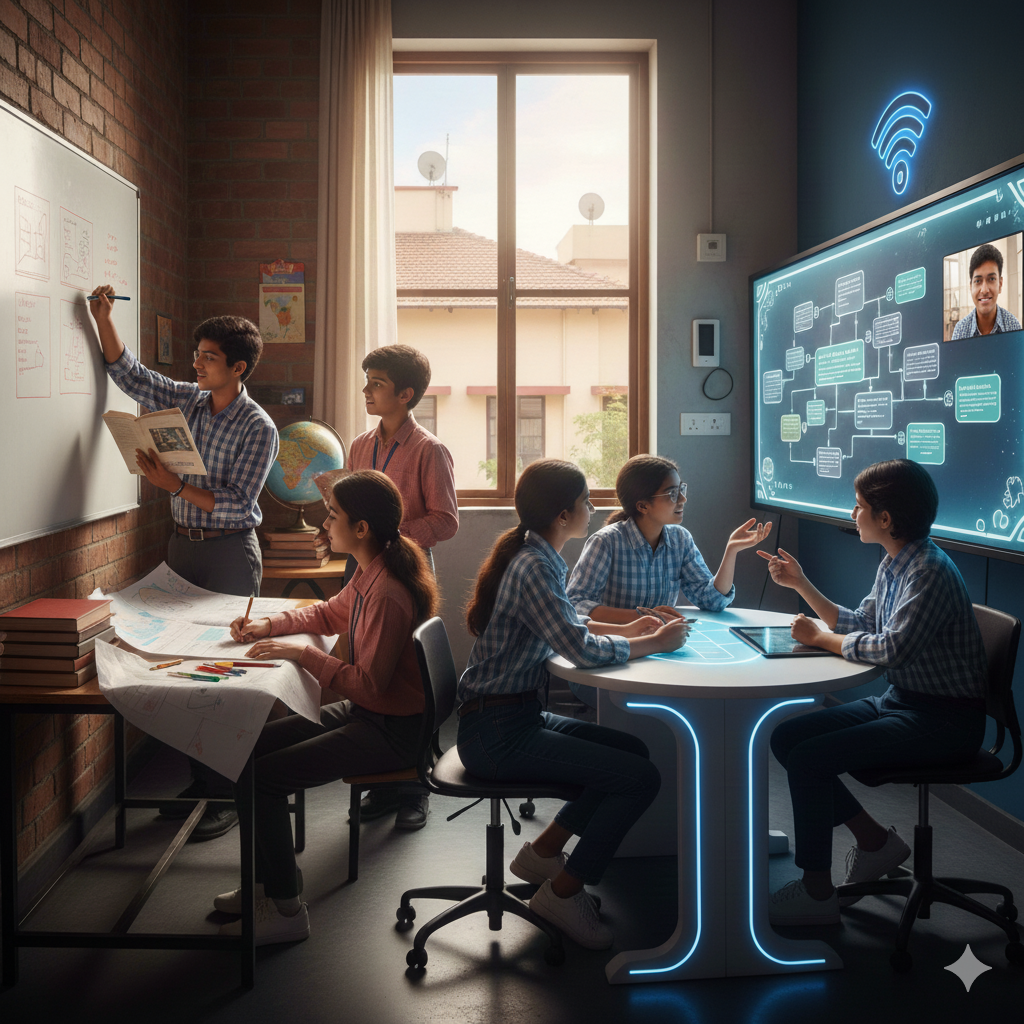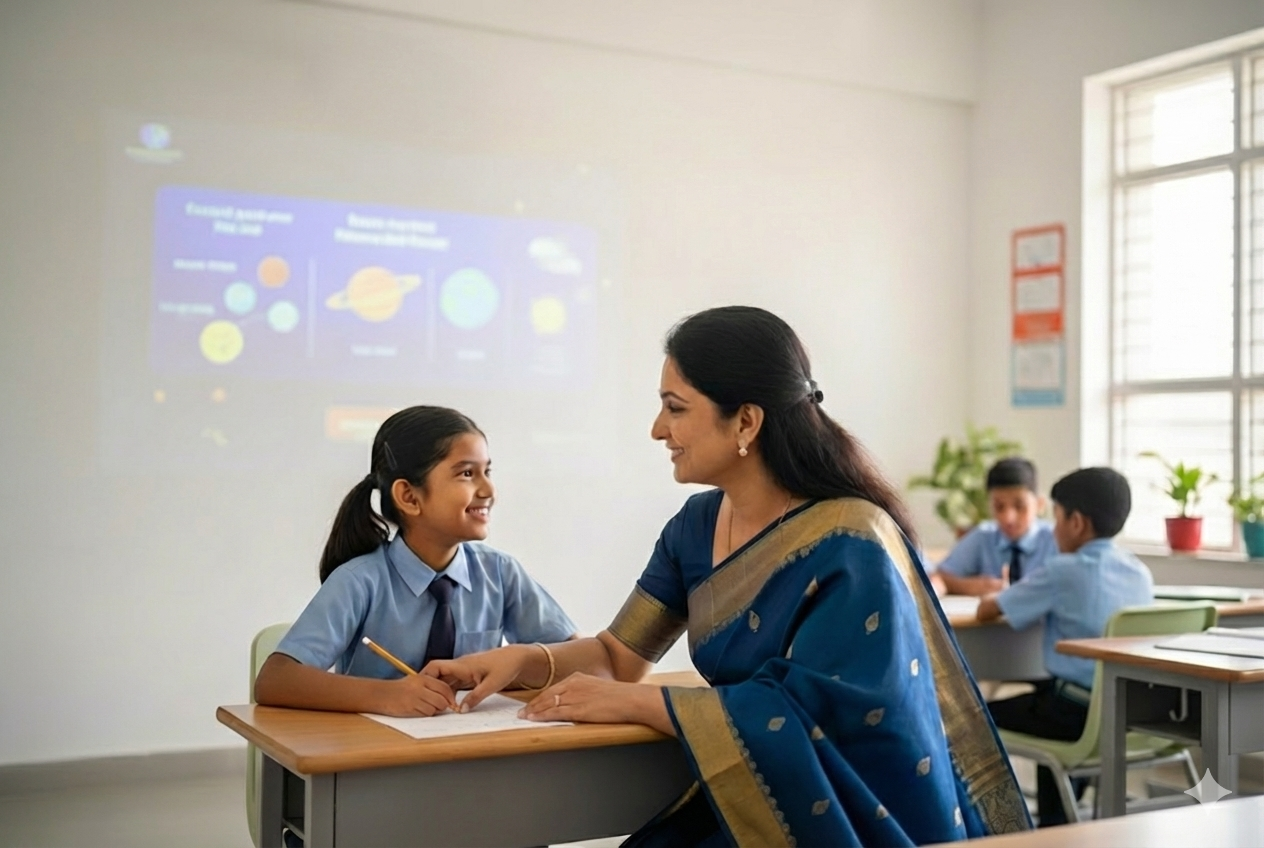Digital Collaboration in Classrooms: Enhancing Hybrid Learning Experiences
.avif)
How many of you have witnessed the shift in education over the past few years? We are sure it’s been a rollercoaster, right? We’ve moved from blackboards to smartboards, from textbooks to tablets. And now, the concept of hybrid classrooms and digital collaboration in the classroom is making waves. But what does this all mean, and more importantly, how does it benefit both teachers and students?
Today, we will break it all down for you, focusing on how we can embrace digital collaboration tools to create modern digital classrooms that truly transform the way we teach and learn.
The Power of Tools for Digital Collaboration in Classroom

So, let’s start with the basics: what exactly are digital collaboration tools? Think of them as the glue that holds digital collaboration in the classroom together, especially in hybrid learning environments. These are tools that enable seamless interaction between teachers and students, whether they’re sitting in a classroom or logging in from home. They allow us to collaborate on documents, assignments, and projects in real time, no matter where we are. This ensures that learning doesn’t stop at the classroom door, and students can engage meaningfully from anywhere.
And here’s where it gets exciting: tools for digital collaboration in classroom aren't just about logging in for a Zoom session. Imagine having a classroom where students can annotate lessons in real time, teachers can share content across devices, and everything is recorded so students can revisit the lesson any time they want. The possibilities for learning are endless!
What is a Hybrid Classroom?
Let’s get to the heart of the matter: hybrid classrooms!
A hybrid classroom is a blend of traditional and online learning, where students are part of the class either physically or virtually. It’s about combining the best of both worlds to give students flexibility and accessibility. Sounds amazing, right? But I know what you’re thinking: “Is this feasible? How will it actually work in practice?”
Let’s break it down. With the right digital classroom setup, hybrid learning becomes not only possible but smooth and highly effective. This is where technology really shines. An interactive projector setup can allow teachers to run simultaneous online and offline classes with ease. Whether your students are physically in the room or miles away, they’ll get the same high-quality learning experience. And guess what? Teachers don’t have to jump through hoops to make it happen.
The Magic Behind Digital Classroom Setup
Now, let’s talk tech—because the tech is where the magic happens.
Imagine this: you walk into your classroom and instead of just a chalkboard, you have an interactive screen that spans from 120 to 200 inches, HD quality, dual cameras set up for recording, powerful speakers, and a super-sensitive mic to ensure every student hears you clearly. Oh, and did we mention the ability to teach in 3D? Yes, we’re bringing sci-fi to the classroom.
Now, why is this crucial? It’s because digital collaboration in the classroom, supported by a powerful digital setup like this, means you, the teacher, don’t have to compromise on how you teach. Want to give a lecture? Go ahead. Want to present a 3D model of the human heart? Done. Want to record the lesson so students can replay it later, from their phones? Absolutely. Hybrid learning is no longer just a theory. With tech like this, it’s a reality already transforming classrooms.
Bridging the Online and Offline Gap
What’s great about this tech is that it tackles one of the biggest challenges we face in education today: the online-offline gap.
Before, students who couldn’t physically attend classes often found themselves left behind. But in a modern digital classroom, we can create an environment where everyone is on the same page—literally. Students can tune in live from their homes or watch a recorded session later in the evening. They can access class materials on their devices, collaborate with classmates in real-time, and never miss out on important lessons.
Think about the possibilities! You’re not just teaching to a room full of students; you’re teaching to a global classroom that exists beyond the four walls.
How Tools for Digital Collaboration in Classroom Help Teachers?

Now, we can understand some of you might be thinking, “This all sounds great, but how does this help me as a teacher? Does it make my job easier, or is it just more work?”
Here’s the good news! Hybrid classroom tools are designed to make your life easier. With a digital classroom setup like the one we’re discussing, you don’t have to juggle multiple platforms or worry about students falling through the cracks. Here’s how:
1. Lesson Recording: Every class is recorded and stored. No more repeating yourself for absentees or students who need extra help. They can access the lesson anytime, from anywhere, right from their pocket.
2. Interactive Tools: With real-time collaboration, students can engage directly with the content. Annotating a document, sharing feedback, or even solving problems on the virtual board becomes a breeze.
3. Seamless Communication: Digital collaboration tools keep communication flowing. Whether you’re assigning homework, grading assignments, or responding to questions, everything is centralized and easily accessible.
This is what we call efficient teaching. You spend less time managing the logistics and more time focusing on what matters: your students’ learning.
Student Engagement in Hybrid Learning
Let’s switch gears for a second and talk about the students because, at the end of the day, they’re the reason we’re all here, right?
Student engagement is one of the biggest challenges we face in today’s classroom environment. In a hybrid classroom, though, we have new tools that boost engagement. Students are more likely to engage with lessons that feel interactive and dynamic.
Here’s how tools for digital collaboration in classroom make this possible:
- Live Interactions: Students can ask questions, answer polls, or even present from their devices, all in real-time.
- Collaboration from Anywhere: Whether in-person or online, students can work together on assignments, making group projects less stressful and more productive.
- Access to Resources: Every lesson, worksheet, and quiz can be stored in one place, so students aren’t scrambling to find the materials they need.
This level of accessibility helps students take ownership of their learning experience, and as we all know, engaged students are more likely to succeed.
What About Assessment During a Digital Collaboration in Classroom?
So, how do we assess students in this new hybrid world?
Assessments in a smart class can go beyond the usual tests and quizzes. With tools for digital collaboration in classroom, you can gauge student understanding through real-time polls, collaborative projects, and peer feedback. You can track their progress in ways that traditional methods simply don’t allow.
But here’s the best part: you can give instant feedback. No more waiting days or weeks to grade assignments. Students get their results quickly, and you can adapt your teaching based on how well they’re grasping the material.
This creates a continuous learning loop where both students and teachers are constantly improving.
The Role of Parents and Stakeholders in Digital Collaboration
And let’s not forget about the parents and stakeholders. They, too, play an important role in hybrid learning environments.
With digital collaboration in classroom, parents can stay informed about their child’s progress without having to wait for a parent-teacher meeting. They can see grades, monitor homework, and communicate directly with teachers, all through the platform.
For stakeholders, this setup ensures transparency and accountability. Schools can showcase their innovative approach to education, attract more students, and provide data that reflects real, measurable improvements in student outcomes.
Conclusion
The future of education isn’t far off in the distance. It’s here, it’s now, and it’s within our grasp. tools for digital collaboration in classroom are the keys to unlocking this future, and as educators, we have the power to lead the way. This isn’t just about flashy tech or trendy gadgets. It’s about transforming the way we teach and ensuring that no student is left behind, no matter where they are or what challenges they face. We have the tools to make learning more accessible, more engaging, and more effective than ever before.
FAQs for Educators
1. What happens if the technology fails? How do we ensure continuity?
Most digital classroom setups come with backup options like cloud storage for lessons and offline modes to ensure that learning can continue even during technical hiccups.
2. How do we ensure that students without access to devices at home can participate?
The beauty of hybrid classrooms is that lessons can be made accessible through multiple platforms. Schools can collaborate with local governments or NGOs to ensure devices are available, or even provide downloadable lessons that can be accessed offline.
3. How do teachers get trained in using these tools effectively?
Most setups for digital collaboration in classrom, including the ones we’ve discussed today, offer comprehensive teacher training. These tools are designed to be user-friendly, but proper training ensures that teachers can make the most of all the features.
Experience Digital Collaboration in the Classroom with Roombr
Ready to turn your classroom into a hub of collaboration, engagement, and innovation? With Roombr’s advanced digital classroom setup, makes digital collaboration in the classroom seamless and impactful. You get an ecosystem designed to simplify teaching and maximize learning. From interactive content sharing to real-time engagement and smart assessments, Roombr helps educators teach more effectively and students learn more deeply, anytime, anywhere.
Want to see it in action? Book a personalized walkthrough and experience how Roombr redefines the hybrid classroom experience.
Praveen Krishnaiah
Share
Step Into the future of
Education with Roombr


















